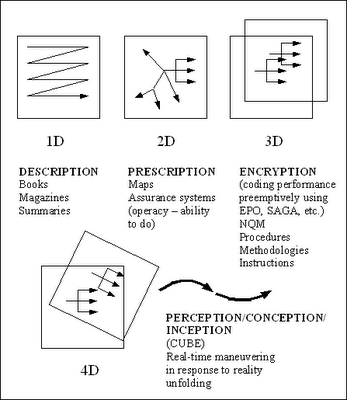4D execution is key to success
 If you haven't had the time to carefully read the 400 postings I wrote so far, it's okay. Don't worry about it. I forgive you. ;-)
If you haven't had the time to carefully read the 400 postings I wrote so far, it's okay. Don't worry about it. I forgive you. ;-)But please, do examine this diagram carefully. It is, I think, one of my major insights as a success intellectual. I think you will benefit greatly from it.
It will take me about 30 postings to explain it, but basically, the insight is that success comes from adaptive execution to proven principles (or four-dimensional execution).
The best way to think of 4D execution is to think of a tennis champion like Andre Agassi or, more recently, Roger Federer.
But let's backtrack and start from the beginning.
1D
One-dimensional information comes from books, magazines, etc. Prose, indeed, is like an arrow pointing in only one direction. Hence, one dimension.
2D
A mind map or a flowchart is better, since it has TWO dimensions. Unlike prose, you can "read" a mind map or flowchart in many different directions.
3D
A procedure is even better, since you've basically considered all your options and have now committed to a specific procedure or methodology or "recipe" or modus operandum. This is where you practice a certain method until you master it perfectly. A martial artist, for instance, would master certain forms and keep practicing those forms.
4D
The real action and the real fun, however, happens at this stage, where you execute a certain procedure, but in a real-life situation (which obviously puts pressure on you). This is the moment of truth. This is where you make it or you break it. And sometimes, no matter how hard you've trained, you can be so nervous that you fail.
As you've probably guessed by now, most people fail in life or in their career or in business, because they are stuck at the one-dimensional stage. They may get an education, read books, go to seminars, etc. but what they are getting is just prose or one-dimensional information.
Nobody "prescribes" any particular action plan for them, so they do not act. They don't even have a map so they can see the various opportunities for action. For instance, pick up any management or business book at the local bookstore, and you will realize right away that those books are descriptive, NOT prescriptive. In other words, they don't tell you what to do to solve your problem.
Yet most people DO have a major problem in life (usually, it's how to make more money!).
Here's an easy way to remember the four phases:
- 1D -- someone gives you a textbook on medicine. It contains fascinating information, but you still have no clue what to do once you put down the book. Even a great book like The 7 Habits of Highly Effective People (by Stephen Covey) is just descriptive. It is just too hard to apply it.
- 2D -- a doctor examines you and prescribes a particular medication. In a business context, the "doctor" would be a consultant hired by a CEO or a high-level executive who wants to solve a major organizational problem.
- 3D -- a pharmacist gives you the prescribed medication, AND instructs you on how and when and how often to take the pills.
- 4D -- you actually swallow the pills at the right time, in the right frequency.
However, this is beginning to change. In the last 10 years, there have been more than 10,000 new success/career coaches.

<< Home